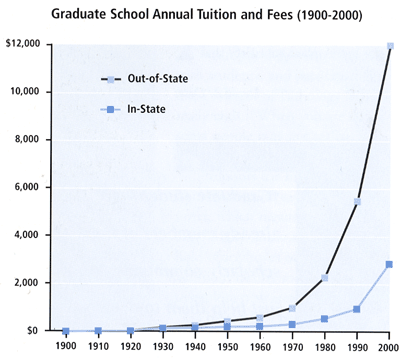

A publication of The Graduate School, University of North Carolina at Chapel Hill
Archives Fall 2000
Home | Back issues | About us | Email your feedback | The Graduate School | UNC-Chapel Hill | Make a gift
The
More Things Change...
A brief history of graduate study at Carolina
Graduate education and the lives of graduate students at Carolina have changed immeasurably since 1853, when the first reference to graduate study appeared in the university course catalogue.
What was considered graduate education then is almost unrecognizable considering today’s standards. The 1853-1854 course catalogue made no mention of either thesis or examination requirements for students in pursuit of a graduate degree, explaining only that, "Those students who seek a professional education may leave the Academic course at the end of the first term of their Senior year, and devote themselves entirely to their own special studies during a period of eighteen months. At the end of six months, they will receive the degree of Bachelor of Arts along with the rest of their class, and at the end of their fifth year, the degree of Master of Arts."
Lacking specific degree requirements, graduate courses, and graduate faculty, the pursuit of an advanced degree more closely resembled an additional year of college than contemporary graduate education.
The Civil War and Reconstruction marked a tumultuous era for the University, which was finally forced to close its doors in 1871, because both funds and students were hard to find. Like many Southern schools, Carolina experienced tremendous setbacks throughout this period; so when the University reopened in 1875, a major goal was to reestablish the University as a sound educational institution; therefore, improving the graduate school became a major priority. Under the leadership of University President Kemp Plummer Battle (1876-1891), a graduate program was officially created in 1876.
Battle’s program brought with it a number of significant changes that essentially redefined graduate education at Carolina. For instance, with a few exceptions, graduate study was now open only to "post-graduates" — students who had already earned the Bachelor’s Degree — as opposed to college seniors. Moreover, while the Master’s Degree still required only one additional year of study, the 1876 catalogue of courses mandated that the graduate student must "pass his examinations and present a satisfactory thesis on some subject within the department of study especially pursued."
One year later, in 1877, the degrees of Master of Arts, Master of Science, and Doctor of Philosophy were announced with the stipulation that they were to be conferred "upon rigid examinations on prescribed courses."
Degree requirements became even more stringent as the graduate program entered the 20th century. Graduate education was institutionalized in 1903, when University President Francis P. Venable (1900-1914) established the department now known as the Graduate School and named Charles Alphonso Smith (1903-1910) its first dean. During the 1920s, graduate education underwent further transformation when Dean Edwin Greenlaw (1920-1925) initiated a massive reorganization of the Graduate School, which included adding a graduate faculty and revising degree requirements.
Although substantial improvements were made in graduate education throughout this period, the Graduate School continued to be plagued by a number of problems, the most pressing of which was a general lack of funds. "In comparison with the offerings of other graduate schools," Dean Greenlaw wrote in his 1922-1923 report, "our position is such as to call for pity. The Graduate School is an orphan child."
...The More They Stay The Same
Despite the fact that both enrollment and required years of study had increased, financial support remained low. The number of teaching fellowships, for example, rose by only a handful throughout the 1920s, growing from 20 in 1920 to 26 by the end of the decade. Women, who were not eligible for teaching fellowships, found themselves in a particularly difficult position. In 1929, the 80 enrolled women were eligible for only two fellowships: the Ledoux Fellowship in Chemistry and the Kenan Fellowship in Philosophy.
At this time, many graduate fellowships and scholarships were not only scarce, but also meager. Very rarely did graduate awards parallel the increasing costs of living. As a result, many graduate students were forced to seek additional means of sustaining themselves and often took up whatever odd jobs were available. This situation, which was both time-consuming and stressful, invariably detracted from students’ academic endeavors.
While funding opportunities for graduate students have certainly improved, working second and even third jobs is hardly an antiquated concept. In fact, when Graduate School Dean William W. Pierson (1929-1958) reported in 1930 that "Graduate students are in general people without adequate means, many of whom are already burdened with debts incurred in obtaining their collegiate and undergraduate instruction," he might just as well have been commenting on the current state of graduate education. Because Pierson’s statement is as telling today as it was 70 years ago, it is apparent that while graduate study at Carolina has changed tremendously, some aspects of the graduate student’s life have stayed the same.
- Laura Micheletti
 |
Early in the century, graduate students only paid a nominal matriculation fee. When tuition was introduced in 1921, tuition and fees totaled only $96 for both in-state and out-of-state students. In fall 2000, tution and fees totaled $2,865 for in-state graduate students and $12,031 for out-of-state students. |
© 2002, The Graduate School, The University of
North Carolina at Chapel Hill
All text and images are property of The Graduate School
at the University of North Carolina-Chapel Hill. Contact Sandra Hoeflich
at shoeflic@email.unc.edu
to request permission for reproduction.
Contact Alexandra Obregon at aobregon@email.unc.edu if you have technical problems with this Web site.